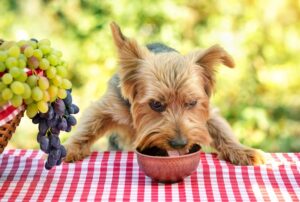If you think that feeding your dog consists of giving him your table scraps with a few vegetables, you’re wrong! His needs are very different from ours. Discover the four-star menus of our four-legged friends!
 |
| Photo by: A. Harris |
A dog’s needs are different depending not only on its size, of course, but on his age, his physiological condition (pregnant or nursing), his lifestyle (sporty or lazy), and his health condition; everything counts! If you take high-quality industrial food recommended by your veterinarian, there is nothing to add to it because it provides your dog with everything he needs. But suppose you insist on making your dog’s food yourself, mainly because you have the time and enjoy it. In that case, you should know that you will always have to add a vitamin and mineral supplement specially designed for traditionally fed dogs (available at the vet’s office and in pharmacies); otherwise, you will run the risk of deficiencies. Finally, whether or not you’re a cook, always serve it in a clean bowl and leave fresh water available. It doesn’t matter if it’s made of plastic or stainless steel, red or grey: unlike cats who attach much importance to their small equipment, dogs are more interested in the content than the container!
 |
| Photo by: Fotyma |
Home-made food for your dog
In addition, in adult dogs, the proportion of meat drops to 35%, 25% vegetables, 30% portions of cereal, and 10% nutrients. And in case of renal insufficiency, which is frequent in older dogs, it is sometimes necessary to lower the proportion of meat to 20% (more digestible poultry) for 50% of cereals, 20% of vegetables, and 10% of essential nutrients.
Industrial food for your dog
It is the most reliable solution by far – everything is there, in the correct dose – and the most practical, especially if you opt for kibble, which is easy to carry around and less expensive than pâté. Once you’ve found the range that suits your dog, please don’t change it. A dog won’t get bored if he eats the same thing all the time. His digestive enzymes can cope with this, but he will get diarrhea if you add new foods. Moreover, he has a very low tolerance to some of them, such as crucifers, legumes, potatoes, bread, and chocolate, which is quite toxic.
Be careful if you fill him with sweets; he will become obese, with a risk of diabetes.